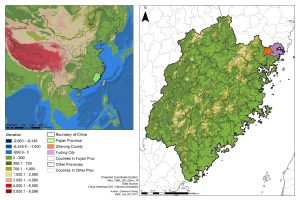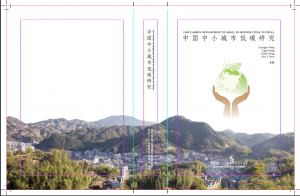Focus
The Chinese government has put in great efforts to establish a low carbon economy as the leading strategy to reduce greenhouse gas emissions (GHG). With this goal of a low carbon economy in mind, there has been an increasing demand for research focusing on the development of these economies, especially regarding the small cities and towns with large GHG emission potentials.
Study Area
This research took place in Fuding and Zherong in Ningde City, Fujian Province. In both of these locations, there is no evaluation system put in place to review each economic sector’s emissions. Fuding and Zherong are both entering the phase of rapid economic growth, therefore having an indicator system to evaluate GHG emissions is critical for the future of low carbon economic development. Therefore this study has chosen to focus on Fuding (small city) and Zherong (small town) in order to facilitate the transition to a low carbon economy.

Map of the study area highlighting Fuding (in purple) and Zherong (in orange).
Methodology
To fulfill the specific objectives of this project, a literature review was conducted to collect information on current regional low carbon development in the world and existing low carbon economy indicator systems. Following the literature review, a Survey to assess public awareness was released and the results were analyzed. A comparative analysis of the results from each city was conducted to determine the preliminary GHG emissions and mitigation potentials. With the above information, the development of a low carbon evaluation indicator system was researched in the literature and developed. Lastly, a literature analysis and evaluations of the low carbon development status in the research area was completed to suggest recommendations for future low carbon economic development and planning.
Timeline
The entire project was completed in two and a half years with the following schedule:
2013
- Literature Review Completed
- Public Awareness Survey Conducted
2014
- Public Awareness Survey Continued
- Comparative Analysis between Fuding and Zherong
- Development of a Low Carbon Evaluation Indicator System
2015
- Recommendations for Future Low Carbon Economy Development Planning
Findings
Low carbon economies have been proposed in different areas in the world as a strategy to mitigate climate change. As the world’s largest greenhouse gas (GHG) emitter, China has put many efforts into developing a low carbon economy as their primary strategy to reducing GHG emissions (Sustainable Development Research Group of Chinese Academy of Science (CAS), 2009). However, there is very little attention to small cities and towns. This research project aims to fill the gap, facilitate a process for raising public awareness and planning for low carbon economy development in small cities in China. It includes three parts: a survey on public perceptions of low carbon economies, a preliminary estimate of carbon emission from 2009 to 2013, and development of a low carbon indicator system that evaluates current states, pressure, and progress of low carbon economy development. The main findings are summarized as follows:
1. Public Perceptions of Low Carbon Economies Survey
Results indicated several possible knowledge gaps and inconsistencies about climate change and the low carbon economy among citizens. However, citizens did indicate high levels of support for developing a low carbon economy in local areas. One-way ANOVA indicated that supporters of low carbon economies were significantly more knowledgeable about climate change and LCE, and they tended to be more supportive of related policies, such as introducing carbon tax on the use of carbon-intensive products than those who were against or not sure about developing a low carbon economy in local areas. There was also evidence suggesting that people who received higher education tended to decide whether or not they support low carbon economies, instead of being unsure about it. However, greater knowledge and more supportive attitudes did not necessarily lead to behavioural changes. This research discovered an ‘attitude-behaviour’ gap between someone showing greater support for low carbon polices (e.g. developing a low carbon economy) and having less intention to change their behaviour (on average respondents had tried three to four low carbon activities and were willing to conduct one more low carbon activity to further lower their carbon footprint). Significant differences were found between the study areas and between different sub-populations, which suggested priorities for further engagement and social learning among the populations of smaller cities in China.
2. Carbon Emission Estimation in Study Areas
Carbon emission of both Fuding City and Zherong County were estimated based on their economic sectors (i.e. GDP of primary, secondary and tertiary sectors) and total energy consumption (coal, petroleum, natural gas, hydroelectricity, and nuclear energy) respectively. Our calculations indicated dramatic increases of carbon emission in both places from 2009 to 2013. Fuding City had a much higher carbon emission in total that increased at a much faster speed. From 2009 to 2013, Fuding City’s carbon emission had doubled from 1,877,621 tonnes to 3,996,609 tonnes (average increase rate = 453,800 tonnes/year), while Zherong County’s emission increased by 50% from 410,769 tonnes to 648,589 tonnes (average increase rate = 47,600 tonnes/year, one tenth of Fuding’s rate). Secondary sector has the most carbon emission, accounting for over 75% of the total emission in both areas. Over 90% of emission from secondary industry is from manufacturing activities.
3. Satellite Imagery Analysis for Carbon Budget and Carbon Change
Results indicated moderate increases of forest land (4% of the total area), agriculture land (4%), and impervious land (less than 1%) in Fuding City, while grassland (8%) and waterbody (freshwater; less than 1%) decreased gradually during 2000-2015. Zherong County also had increased forest land (10%), agriculture land (1%), and water body (freshwater; 2%), but decreased impervious land (1%) and grassland (4%) over the same period of time. Although forestland with positive contribution to carbon budget increased in the study areas overtime, both areas were carbon deficits (i.e. carbon source) due to rapid urbanization.
4. Low Carbon Economic Development Evaluation
The study adopted OECD’s Pressure-State-Response (PSR) model for low carbon economy assessment. Assessment criteria includes pressure (social economy pressure and natural conditions), state (human development, and ecological environment), and response (economic capability, cultural education, and organizational systems). Since 2009, both Fuding City and Zherong County had progressed towards a low carbon economy, with low environmental pressure and human disturbances, high ecological resilience, and overall high potential of low-carbon development. On the other hand, results suggested that more efforts were needed from the government and local citizens to progressing towards a low carbon economy (e.g. reform industrial structure, increase energy efficiency).
5. Recommendations for future low carbon economy development planning
Raise Public Awareness – Survey results highlight the need for more government efforts on public education regarding climate change and low carbon economies. These efforts would include providing more reliable information sources or educational programs, ‘translating’ complicated scientific terminologies into easy-to-understand and relatable languages, using multiple channels especially mass media like TV and internet to engage the public, develop active public engagement programs in various forms (e.g. workshops, community meetings, neighbourhood social gatherings) to foster interactive communication and collective actions.
Increase energy efficiency – Given the major contribution in carbon emissions from secondary industry, several suggestions were made on reforming industry structure and increasing energy efficiency to meet city’s goals of saving energy and reducing carbon emissions. These suggestions include transforming from energy intensive industries to technologically intensive ones, putting more emphasis on developing primary and tertiary industries (e.g. agriculture and tourism), improving infrastructure in industrial areas, and developing clean energy sources (e.g. hydroelectricity, wind power, solar power, and nuclear power).
Improve infrastructure– Besides public education programs, the local government could introduce more supportive infrastructure (e.g. garbage segregation and recycling system) to enable more low carbon activities. The government could also introduce incentive mechanisms to promote clean energy and recycling.
Enhance carbon sinks – Forests, grasslands, and wetlands play important roles in emission reductions due to their ability to sequester carbon from the atmosphere (i.e. they are carbon sinks). The local government could put more efforts into increasing these carbon sinks: for forest carbon sinks, the local government could improve current forest management, afforest/reforest to increase forest cover and its ecological values, and develop forest biomass energy. For grassland and agricultural land, the local government could focus on improving energy efficiency, recycling agricultural wastes, scaling up current practices and planning, developing eco-tourism, and introducing more technologies to reduce carbon emissions. The most serious issue for wetland ecosystems in both study areas is pollution. Therefore, the local government could introduce more strict regulations on preventing pollutions in wetlands from nearby manufacturing plants and farms.
Complete the legal framework – The local government should start building a legal framework for local and intra-region low carbon development, which includes specific regulations on energy use, carbon emissions, and incentive mechanisms for saving energy, recycling and increasing carbon sinks (e.g. tax reduction, preferential loans).
Book Cover: Low Carbon Development of Small to Medium Cities in China

